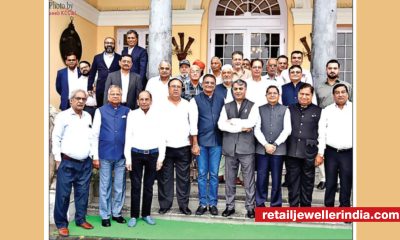Daily News
New museum in Jaipur trains the spotlight on 2,000-year-old art of minakari enamelling

The Museum of Meenakari Heritage (MOMH) in the Pink City is the brainchild of jewellery designer Sunita Shekhawat, who launched it to celebrate her 25-year journey in the jewellery business
Jaipur: Well-known jewellery designer Sunita Shekhawat has put together The Museum of Meenakari Heritage (MOMH) in Jaipur to celebrate 25 years of being in the jewellery business. “I wanted to be able to give back to the city that has given me so much,” Shekhawat told The Week about the museum that opened in the Pink City in March. “The museum is truly a vision of the people, for the people and by the people,” she added.
The museum has been curated by scholar, author and jewellery historian Dr Usha Balakrishnan, whose mastery of story-telling and research is evident on the walls just as Shekhawat’s mastery in enamelling is showcased in the jewellery on display. “In Europe, enamelling work was on the front and the back of jewels. In India, it got relegated to the back because we used the kundan technique (gems wrapped with real gold foil before being set in the frame) in the front,” says Dr Balakrishnan, who has traced the history and art of enamelling in India from the 16th century to the present with more than 300 images and 100 historic reproductions.

Minakari enamelling – an ancient technique that makes intricate designs with coloured glass layered with gold – is more than 2,000 years old as a craft; there’s evidence of it in Greece, Mesopotamia and Etruscan cultures. Then it went through a lull and died out in Europe; it was revived in the Byzantine period again, during the Ottoman rule. But in India, in the excavations of Takshila and Sirkap, two enamelled necklaces were discovered which are now in the national museum. This was in the first century; then right up to the 16th century, there is no evidence of enamelling in India or mention of it in any text. It’s amazing that enamelling is not indigenous to India but has become such a part of its local lexicon, having suddenly flowered with the arrival of the Portuguese in India.
The museum is a grandstand of what minakari work is capable of. Different techniques of enamelling like cloisonné, champlevé, plique-à-jour, and basse-taille are showcased here. Many pieces are reproductions of historical pieces, such as oddly-shaped archer’s rings, or a sarpech (turban ornament, which is now in the Museum of Fine Arts, Houston), or drawn from jewels from miniatures. The MOMH does not have genuine antiques.
An audio-visual and a real-life showcase present how the artisans work on the jewels, where each colour of powdered glass is set to a different temperature in the kiln separately. European flowers such as poppies and irises are shown as botanicals, then as Mughal representations, and then finally as little enamels in jewels. It is an extraordinary depiction of how the human hand and eye is capable of such finesse in such small proportions.
The Museum of Meenakari Heritage is a three-story flagship space spread over 2,200 square feet. It has sourced rare images of minakari work from the British Museum, Victoria & Albert Museum, Sotheby’s, the Al Thani collection and the Aga Khan Museum.
Courtesy: The Week

 Personal Opinion2 weeks ago
Personal Opinion2 weeks agoBuy-back on gemstones to be on par with gold; A fear of return on the investment, more among high-end clients: Ankur Anand, Harsahaimal Shiamalal Jewellers

 Maverick Greenhorn1 month ago
Maverick Greenhorn1 month agoSegmenting retail approach to boost business performance

 Exclusive4 weeks ago
Exclusive4 weeks agoPrasad Jewellers’ Gold Bar Challenge fulfils multi-channel engagement goals, attracts young customers

 Daily News2 weeks ago
Daily News2 weeks agoTBZ – The Original launches its first store in Jaipur































